The presidential campaigns have virtually ignored the internet as an advertising medium, according to the first-ever systematic study of online political ads. The campaigns have spent more than $100 on television ads for every dollar they have spent on web ads. The few ads that ran online between January and August 2004 mainly sought $25 and $50 campaign contributions.
The presidential campaign world today regards the internet as an asset for fund-raising, voter-profiling, and insider communication, but not for advertising.
Since January 1, 2004, Evaliant Media Resources, a TNSMI/CMAG affiliate company, has monitored more than two thousand commercial web sites on a daily basis. Evaliant has archived each political ad its tracking technology has encountered, noting the ad’s web page location, and estimated the amount of money spent to place the ad. A systematic review and analysis of ads placed online by the presidential campaigns, the national parties, and 527 advocacy organizations during the first eight months of 2004 reveals that:
» The primary players in presidential politics this year spent just $2.66 million on online banner ads between January and August–less than 1% of the buy for television ads in the top 100 markets. Preliminary spending analysis for September shows little change in this pattern, despite the start of a ban on broadcast and cable election ads paid for with soft money. By contrast, between March 3 and September 20, 2004, according to a CMAG estimate, the campaigns spent $330 million on television advertising in the top 100 markets.
» The Kerry campaign has outspent the Bush campaign by a 3:1 margin: $1.3 million by Kerry, $419,000 by Bush. The Democratic National Committee ($257,000) has picked up its online advertising since July, but has spent a little over half of that spent by the Republican National Committee ($487,000).The 527s (advocacy groups such as MoveOn.org and Swift Boat Veterans for Truth which are taking advantage of campaign finance law loopholes) have done very little online advertising: $184,000, with $104,000 by the MoveOn.org Voter Fund.
» Strategically, the Bush campaign aimed its online advertising at middle-class women and voters in battleground states in one big blast in May ($403,000 of the $419,000 total). The Kerry campaign concentrated on raising money from progressive outlets in metropolitan areas. Both campaigns preferred local to national and global news outlets, and web sites of “old media” properties to those of online companies.
» The most popular purpose of the ads was to raise money, usually solicited in $25 and $50 amounts. A few ads sought to recruit volunteers. A few made statements about the candidates and issues without calling for money or volunteers. No ads contained endorsements or invitations to campaign events.
» The biggest online ad buys for Bush were at these sites:
- KPTV Oregons12.tv.com (FOX, Portland OR)
- Parents.com (Parents magazine)
- KNVA-TV.com (WB network, Austin TX)
- El Nuevo Herald.com (Miami FL)
- KPHO CBS 5 News.com (CBS, Phoenix AZ)
» The biggest online ad buys for Kerry were at these sites:
- SFGate.com (San Francisco Chronicle newspaper )
- Newsweek.com (Newsweek magazine)
- Village Voice.com (New York City NY alternative weekly newspaper)
- Reuters.com (Global news service)
- L.A.Weekly Media.com (Alternative weekly newspaper)
» Although parts of the online world are a public “wild West” where few standards of taste, civility, and accuracy prevail, political advertising on the internet has adhered to mass media standards of political discourse. Content analysis of the 137 ads in the collection by the Bush, DNC, Kerry, and RNC campaigns pre-conventions shows that although a few ads took remarks out of context, none descended to obscenity, graphic violence, or manifest smears and lies. A majority (56%) of the ad designs analyzed either praised the sponsoring candidate or concluded a candidate contrast on a positive note.
INTRODUCTION: Where are the ads?
Presidential campaigns have incorporated the internet into their activities to a greater degree than in 2000. They have learned from the spectacular successes of Democrat Howard Dean’s campaign, and from the small realizations which accrue as people spend more time with a new technology. Specialists in online politics have been lobbying the campaigns to try more things on the new medium, partly out of self-interest, of course, but partly out of the sensible belief that use of the internet can improve on the status quo. The internet offers creative opportunities in multimedia expression. It costs little to produce online messages and make them available to others. The internet gives campaigners the opportunity to codify, test, discuss, and refine their messages and operations–in sum, to sharpen their collective intelligence. Finally, few legal restrictions stand in the way of what can be tried online.
The campaigns have tried some new things. This year, for the first time, both presidential candidates invited people to visit their web sites during their nomination acceptance speeches. Bush and Kerry campaigners are organizing house parties, making videos and sound files especially for online distribution, posting interactive games, and narrating the campaign from their point of view in multiple listserv missives a week. Tens of millions of dollars have been collected with the help of the internet, most notably from small donors. (Exact online fundraising amounts are not reported to the government, and are to some extent incalculable, since online appeals may be answered through a phone call or letter, and vice versa.) Both parties have amassed and analyzed data identifying the personal traits, consumer preferences, and voting behavior of more than one hundred million citizens, in order to pinpoint canvassing activities and refine mobilization appeals.
Yet for all the online experimentation the campaigns have attempted this year, they have not ventured aggressively into online advertising. This is somewhat surprising because online ads can reach new, undecided, and wavering voters in the demographic and geographic niches where they are thought to reside.
Online ads would seem to provide a missing link between the campaigns’ existing internet efforts and tens of millions of Americans. Industry estimates say overall spending on online ads is growing faster than in any other medium, and is expected to top $8 billion in revenue by the end of 2004.1 Yet the presidential campaigns have moved tentatively into the field, as analyses of the spending, content, and placement to date discloses.
SPENDING2
As Table One and Chart One show, the presidential and national party campaign organizations accounted for 93% of the estimated ad spending detected through the Evaliant software in the first seven months of 2004: Kerry for President (49.5%), the Republican National Committee (18.3%), Bush for President (15.7%), and the Democratic National Committee (9.7%). The 527s have largely ignored online advertising. (As of the first week in September, Swift Boat Veterans for Truth had not run any online ads.)
TABLE ONE: SPENDING ESTIMATES BY MONTH
CHART ONE: JANUARY-AUGUST SPENDING BY PROPORTION
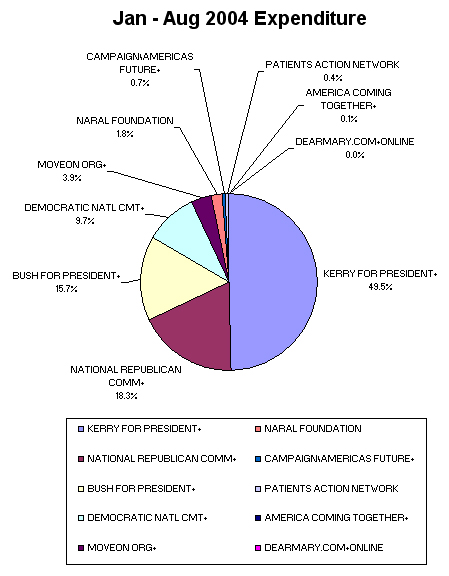
{Ed. Note: For both of the above charts, please also see Excel document, available here}
The current total of $2.7 million is less than half of what the John Kerry campaign raised in contributions from the internet in a single day: $5.7 million on July 29, the day Kerry gave his nomination acceptance speech.
CONTENT
An examination of the 137 online ads deployed by the Bush, Kerry, DNC, and RNC campaigns between January and July 2004 reveals that the advertisements have consisted mostly of slogans and graphics of the sort found on bumper-stickers and billboards, with occasional forays into flash animation. The online ads were notable more for the messages they did not contain, rather for their content. For example:
- No campaign ad contained a political endorsement, even though that is a familiar practice in listserv emails, automated phone calls, and direct mail.
- No campaign ad issued invitations to political events or meetings.
- Very few ads attempted to build enthusiasm among voters as the candidates were going into or coming out of primaries and financial disclosure deadlines. Again, this is striking because such messages are a common feature in other campaign media.
- Only a small number of ads contained messages targeted to groups, states, or other segments of the population that are strategically important to the campaigns. This is so despite the fact that the campaigns made careful choices reflecting targeting strategies when they made ad buys.
- Only one ad invited viewers to click to a specific message: a banner in which Laura Bush asked readers to “Let me explain why” the president shares her passion for education. The ad linked to a 2 ½-minute video which in turn contained a 30-second ad also shown on television.3 This was clear effort at persuasion, as the placement analysis in the next section confirms.
Some observers anticipated that the unfiltered and unregulated status of the internet might induce campaigns to run underhanded attacks through advertising. A general concern about internet political communications motivates the bill sponsored by Senators Lindsay Graham and Ron Wyden to apply the “Stand By Your Ad” disclaimer requirement to the internet.
Despite those concerns, the online ads to date were no better or worse than those in other high-visibility media. There were no glaring falsehoods or really low blows. As Table Two shows below, 56% of the ad designs either praised the sponsoring candidate or concluded a candidate contrast on a positive note. Only the Bush campaign designed more negative than positive ads; however, the single positive ad –the Laura Bush banner with the “special message” link to a video– accounted for 98% of its placements.
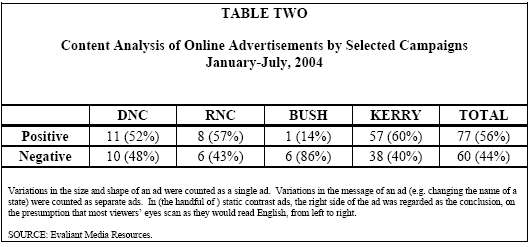
A heavy majority of the Kerry and DNC ads (78%) had fund-raising as their main purpose. Bush and RNC ads focused more on recruitment and persuasion (57%). Only the RNC sought to register voters through online ads. Table Three summarizes the text for the five most frequently spotted advertisements by the big four campaigns. They run the familiar gamuts from the vacuous to the substantive, from the straight-forward to the shifty. There has been humor, outrage, and a little outrageous humor, albeit nothing to compare with some of the videos posted by the campaigns.4
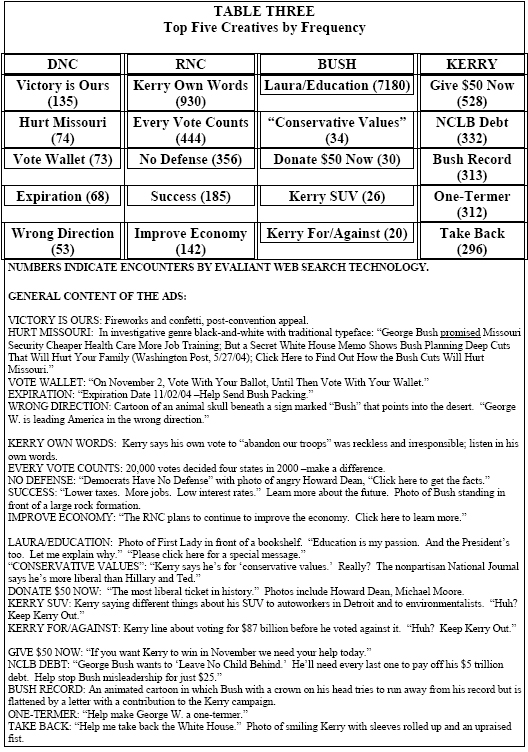
PLACEMENT (With research assistance by Alex Storey)
Online ads provide a campaign with great versatility in placement options. Ads can be purchased on the web counterparts of most media outlets (e.g. local television stations, specialized magazines, national radio networks), as well as on portals (AOL), marketplaces (eBay), blogs, and other sites analogous to physical locations. Thus, a web buy can complement or substitute for buys in almost every other medium.
The Bush and Kerry campaign ad buys prior to the conventions reflected different priorities. As Tables Four, Five, and Six detail below, the Bush campaign aimed one big blast at middle-class women and voters in battleground states, while the Kerry campaign concentrated on raising money from progressive outlets in metropolitan areas. Both campaigns preferred local to national news outlets, although the Kerry campaign spent much more on national news outlets. Neither campaign sought ads in national political magazine web sites, with one exception, a single Bush placement on NationalJournal.com.
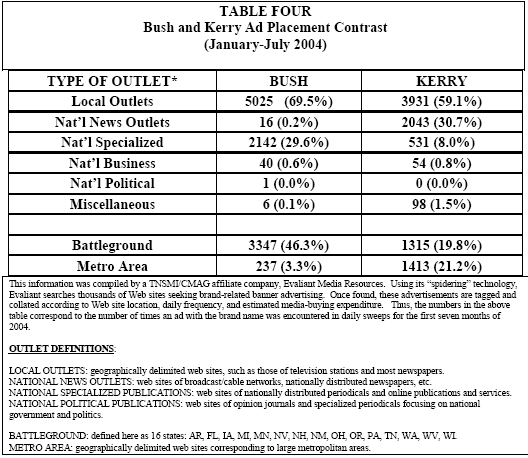
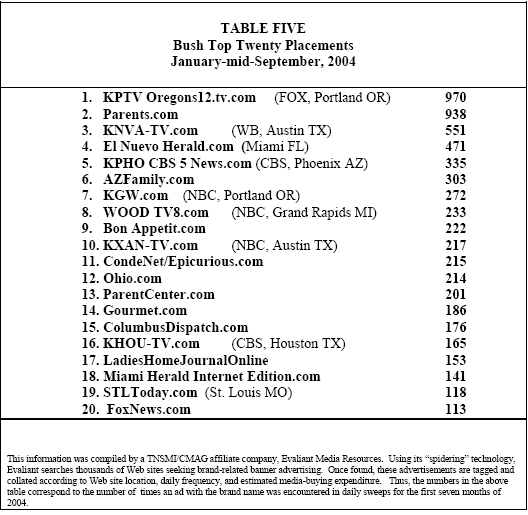
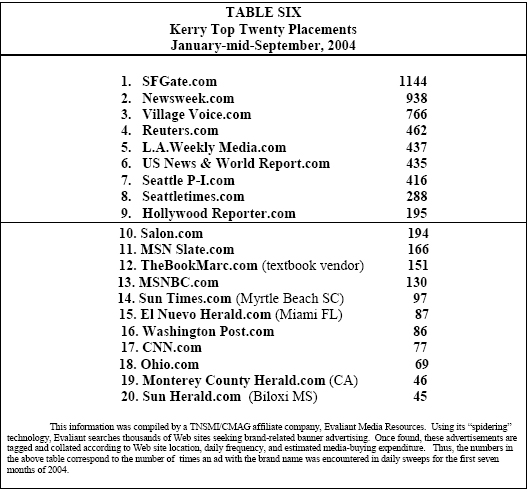
Parenting web sites (which also include ParentCenter.com, AmericanBaby.com and family.msn.com) made up 16.5% of Bush ad occurrences. Parents.com (the web site of Parents Magazine), according to its advertising kit, has as its typical visitor a 32 year-old mother with children under the age of 3. Gourmet.com, Epicurious.com, BonAppetit.com, LadiesHomeJournal.com and BetterHomesandGardens.com accounted for 11.4% of Bush ad occurrences; the average visitor to Gourmet.com (Gourmet Magazine’s web site) is a 44 year-old college educated woman who works full time and has a median household income of over $74,000. This demographic pattern, along with the content analysis, suggests that the preeminent interests were in persuasion and perhaps recruitment of middle-class women to the Bush campaign. The absence of buys after May suggests that the Bush campaign regarded this foray into online advertising as a failed experiment. Others note that there might have been a small chance for any political ad to succeed during this period because the national attention was riveted on stories about abuse of Iraqi prisoners in Abu Ghraib.
Five national news sites – newsweek.com, reuters.com, usnews.com, slate.com and salon.com – accounted for a third (32.9%) of Kerry ad occurrences. The top site was Newsweek.com, a part of MSNBC.com. It attracts an equal amount of men and women. They are relatively young (74% age 25-54), middle-class (69% have a household income of $50K+), married (69%), and well educated (59% have at least a college degree). Six sites aimed at metropolitan area readers, especially progressives, accounted for 49% of the Kerry buy: SFGate, Village Voice, LA Weekly, Hollywood Reporter, and the web sites of the two Seattle daily newspapers. This pattern, again in conjunction with the content analysis, suggests that the Kerry campaign’s predominant interest was in fundraising.
There was not great effort in either campaign to coordinate its online advertising with its advertising on television. We compared local ad placement preferences with those for television ads, as tabulated by the Nielsen Monitor-Plus and the University of Wisconsin Advertising Project.5 The Bush campaign placed online ads in only 2 of the top 10 markets for its television advertising (Detroit MI and Wilkes Barre-Scranton PA), and Kerry placed online ads in only 1 of the top 10 markets for its television advertising (Cleveland OH). Preliminary analysis of August data shows more overlap in that month. However, the Bush campaign has purchased no online ads in September, with only 102 ads encountered for August (all on FoxNews.com); ads by the Kerry campaign were encountered by the Evaliant technology 34 times in August and 26 so far in September.
CONCLUSION
Presidential campaigns play a special role in the American r political system: they are the main venue for communication between the nation’s leaders and its sovereign citizens. For decades, the dominance of mass media have inculcated a sense of spectatorship among the citizenry. Mass media have also driven up the cost of campaigning. The internet has the potential to include more voices in the campaign dialogue, from aggregations of individual preferences in polls, to sequential discussions in blogs, to synchronous participation in conference calls and online chats.
The 2004 presidential campaigns have acted on that potential in creative ways. The Bush and Kerry campaigns have employed a variety of internet tools to recruit volunteers, raise money, and engage new voters through their web sites, email efforts, use of blogs, and social networking activities such as Meetup.com. What they do not yet seem to believe very deeply is that aggressive online advertising might have a payoff.
METHODOLOGY
This information was compiled by a TNSMI/CMAG affiliate company, Evaliant Media Resources. Using its “spidering” technology, Evaliant searches thousands of Web sites seeking brand-related banner advertising. Once found, these advertisements are tagged and collated according to Web site location, daily frequency, and estimated media-buying expenditure. Each time the spider sees an ad on a web site page, that is counted as an encounter; an ad placed on three different pages of one site on one day would thus yield a count of three.


